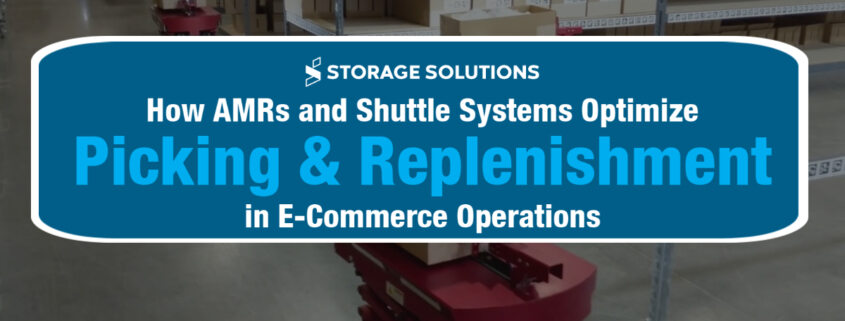How AMRs and Pallet Shuttles Optimize Fulfillment
It is no secret that e-commerce continues to take a larger and larger share of total retail sales. Throw in a pandemic that forced millions of people and businesses to shop from home, and you will find that fulfillment centers, distribution centers, and warehouses are increasingly searching for methods to optimize fulfillment while minimizing how expensive that process can be.
For operations designed for more traditional case-or-pallet distribution, that process can be costly.
For instance, let us say a facility was outfitted with a large, three-story pick module with a 100,000 sq. ft. footprint. They formerly relied on forklifts to move a whole pallet of products from storage to shipping. Now, they see an increasing share of orders requiring just one or two items from that pallet, requiring a human to physically travel, find the item, and bring it back to packing, where it will be packaged and shipped. All of those new processes add up in terms of labor costs, packing, and shipping costs. Plus, order accuracy and fulfillment times are now in question. How does a company react?
After all, let us say in this example, the business is just emerging from a disruptive year and have this significant, fixed pick module asset that they are a little unsure of how to optimize their picking and replenishment processes, which are getting more expensive by the day. They see growth in e-commerce orders, but is it here to stay? Is making an investment in a fully automated storage and retrieval system (AS/RS) worth it? Are there alternatives?
Not many businesses can avoid facilitating e-commerce orders. Maybe the order volume or SKU variance is not as high in their warehouses as the nation’s biggest retailers. However, they still see an increase in fulfilling these orders. The answer may rest with a strategic investment in automated mobile robots (AMRs) and top-of-the-line software.
How AMRs Optimize Picking and Replenishment in E-Commerce Operations
Autonomous mobile robots (AMRs) are becoming a popular solution to challenges stemming from the sudden explosion of e-commerce demand, primarily because they can move products within a facility without substantial infrastructure investments.
AMRs can travel, pick, transfer, and replenish warehouses across a nearly infinite number of SKUs with fantastic accuracy. With their diverse set of applications, they help reduce reliance on human labor and allow your associates to remain in critical locations and be dedicated to higher importance tasks than walking around a facility.
Some AMRs even bill as a monthly cost, so you can begin implementing them without affecting as much cash flow as a pick module would. Then they offer the flexibility to scale up with additional robots as your business needs change.
For those who have installed multi-level pick modules and boast small-to-mid-sized e-commerce operations, AMRs solutions can be a cost-effective solution to lower labor costs and increase throughput on e-commerce orders. With these solutions, businesses are not required to reconfigure their operations while running.
These solutions also remove the most significant obstacle facing the adoption of automation – that initial investment – by retrofitting into existing structures like pallet racks or pick modules. Because they can be integrated into your currently-existing facility, they can offer a return-on-investment on day one through cost savings and labor throughput.
How Shuttle Systems Optimize Picking and Replenishment in E-Commerce Operations
Around the middle of the 2010’s, shuttle systems – also henceforth referred to as automated storage and retrieval systems (AS/RS) – began to be refined in European supply chains and have since made their way to the United States. According to the Material Handling Industry glossary, AS/RS is a generic term that “refers to a variety of means under computer control for automatically depositing and retrieving loads from defined storage locations.”
They are essentially bi-directional shuttles that are programmed to be packed with a product on a tote or cart, travel along a designated path, and then place the product into a high-density storage unit. When that product is ordered, the cart will automatically retrieve it and deliver it back to a packer, who then prepares the product for shipping.
These goods-to-person systems eliminate the need for massive pick modules and the manual process of your labor force walking and storing, then walking and picking, then walking the product back to a pack station.
By utilizing an AS/RS, companies can save a tremendous amount of time and resources involved with placing products into storage and then retrieving those items once ordered. Instead of having that worker physically travel to locations along a path, the worker can stay in one place while the machines do the intensive labor.
There are also crane-based and cart-crane-based AS/RS solutions, which you can read about here.
Which Set of Solutions is Right for You?
Both shuttle systems and AMRs significantly reduce the highest variable expense in the fulfillment process: labor time spent on walking. Both answers will ultimately deliver their ROI by reducing labor costs and increasing labor productivity, perhaps faster than you may think. The right solution for your operation will depend on how you go about bringing your goods to your people in the most efficient way possible.
Determining the proper course of action in adopting new technology and equipment should start with defining a strategy to get your business to its next stage. Taking a piecemeal approach can leave you with a suboptimal workflow, slower fulfillment times, and higher operational costs.
Our team of experts has decades of experience finding the proper storage and fulfillment solutions installed and integrated with a short-term ROI in mind and an eye on long-term growth for the business.
Give us a call and let us uncover your challenges and provide insight into solutions to help your operations adapt to the ever-increasing role that e-commerce has with your business.




